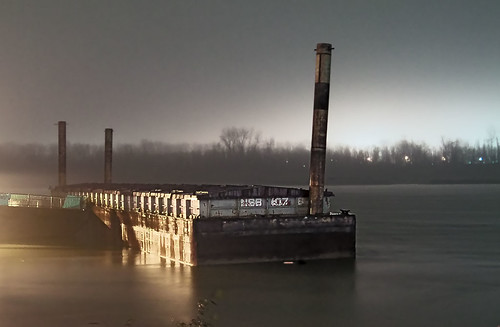
Barge, on the Missouri River, in Saint Charles, Missouri.
Located a number of miles up from where this river flows into the Mississippi, Saint Charles is the first high (and flood-safe) ground on the Missouri, making this location a natural place of human settlement.
The first European mention of the river was in the journal of Father Jacques Marquette, S.J., in 1673, recording its Illinois Indian name Pekitanouï. Also during this expedition, he named the Mississippi the Immaculate Conception River.
Marquette also mentioned a tribe living near the mouth of the river, the Oumessourita (an Illinois Indian name), from which ultimately we get the name Missouri; however, this tribe called themselves the Niúachi.
The river was formally charted and given its current name by Étienne de Veniard, Sieur de Bourgmont, in documents written in 1713 and 1714, where he also gives names for the river's tributaries. For the most part, we have retained the French names for these streams.
The river was historically an important highway for transportation, reaching its peak in importance in the 1850s, later being eclipsed by the railroads. While no longer seeing much passenger transport, the river remains an important route for the shipment of bulk commodities such as grain, coal, and iron.
2,341 miles (3,767 kilometers) long, the Missouri is one of the world's great rivers, and drains over half a million square miles.


What you are looking at is a "spud" barge. The 3 large round posts are called spuds. These can be lifted up to move the barge. Once the barge is put in a place where they want it to the stay, they drop the spuds and the barge is stationary at this point. Think of them as huge tent steaks.
ReplyDeleteThese barges are used a lot of times as a mooring spot for either a temporary fleet or just a place to hold a few barges to work on project like building levees.
Thanks! I was wondering about it.
ReplyDelete